Oil Spill Identification with Marine Radar Using Feature Augmentation and Improved Firefly Optimization Algorithm
Highlights
- To address the need for precise extraction of oil spill regions of interest, a Local Binary Pattern (LBP) feature enhancement method was introduced.
- Specific optimizations were strategically applied to the Firefly Optimization Algorithm for better adapt to the complex noise characteristics of marine radar signals. These targeted improvements enabled the algorithm to more effectively distinguish oil film targets from background interference.
- Precise identification of regions of interest (ROIs) serves as the foundational step in oil spill monitoring systems. The extracted ROIs thus provide the critical spatial context for achieving high-confidence oil film detection through feature fusion enhancement method.
- The improved firefly algorithm demonstrates superior adaptability for oil film segmentation tasks in complex marine radar imagery, effectively addressing challenges posed by sea clutter and low contrast. This innovation provides a robust technical framework for real-time marine oil spill monitoring systems, enabling high-confidence detection in dynamic ocean environments.
Abstract
1. Introduction
2. Experimental Data and Methods
2.1. Experimental Data
2.2. Pre-Processing Data
2.2.1. Coordinate System Conversion
2.2.2. Co-Frequency Interference Noise Reduction
2.2.3. Spot Inhibition
2.2.4. Global Grayscale Correction
2.2.5. Local Contrast Enhancement
2.3. Local Binary Pattern
- (1)
- LBP eigenvalues are extracted from the given image as:
- (2)
- Then, a mean filtering of the 64 × 64 window was performed on the LBP feature map.
2.4. Histogram of Oriented Gradient
- (1)
- Gradient calculation
- (2)
- Cell histogram statistics
- (3)
- Block normalization
- (4)
- Feature stitching
2.5. K-Means Clustering Algorithm
- (1)
- Initializing centroids
- (2)
- Allocating data points to K clusters
- (3)
- Updating centroids
- (4)
- Repeating iteration
- (5)
- Outputting clustering results
2.6. The Improved Firefly Optimization Algorithm
- (1)
- Initialization
- (2)
- Brightness Evaluation
- (3)
- Attractiveness and Movement
- (4)
- Iteration and Termination
3. Results
3.1. ROIs Extraction
3.2. Oil Film Segmentation
4. Discussion
4.1. Comparation with Another Effective Oil Spill Monitoring Region Extraction Method
4.2. Comparison of Different Filtering Methods in Effective Oil Spill Monitoring Region Extraction
4.3. Comparison of Another Marine Radar Oil Spill Detection Method
4.4. Comparison with the Traditional FA Model
4.5. The Challenge of Calm and Harsh Waves
5. Conclusions
Author Contributions
Funding
Data Availability Statement
Conflicts of Interest
Correction Statement
References
- Ji, H.; Wang, T.; Wang, Y.; Yang, K.; Jiang, J.; Xing, Z. Influence and Prediction of Oil Film Migration in Submarine Pipeline Spills under Multiple Factors. Process Saf. Environ. Prot. 2023, 178, 74–86. [Google Scholar] [CrossRef]
- Chen, Y.; Zhou, S.; Yu, W.; Hu, H. A Novel Environment-Adaptive Dual-Light Image Enhancement Framework for Marine Oil Spill Detection. Mar. Pollut. Bull. 2024, 209, 117257. [Google Scholar] [CrossRef]
- Sun, Z.; Yang, Q.; Yan, N.; Chen, S.; Zhu, J.; Zhao, J.; Sun, S. Utilizing Deep Learning Algorithms for Automated Oil Spill Detection in Medium Resolution Optical Imagery. Mar. Pollut. Bull. 2024, 206, 116777. [Google Scholar] [CrossRef]
- Scarlett, A.G.; Nelson, R.K.; Gagnon, M.M.; Reddy, C.M.; Grice, K. Very Low Sulfur Fuel Oil Spilled from the MV Wakashio in 2020 Remains in Sediments in a Mauritius Mangrove Ecosystem Nearly Three Years after the Grounding. Mar. Pollut. Bull. 2024, 209, 117283. [Google Scholar] [CrossRef]
- Boesch, D.F.; Cebrian, J.; Fonseca, V.F.; Landers, S.C.; Marshall, N.J. Editorial: Vulnerability and Resilience of Marine Ecosystems Affected by the Deepwater Horizon Oil Spill. Front. Mar. Sci. 2023, 10, 1253605. [Google Scholar] [CrossRef]
- Lau, T.-K.; Huang, K.-H. A Timely and Accurate Approach to Nearshore Oil Spill Monitoring Using Deep Learning and GIS. Sci. Total Environ. 2024, 912, 169500. [Google Scholar] [CrossRef] [PubMed]
- Freeman, D.H.; Nelson, R.K.; Pate, K.; Reddy, C.M.; Ward, C.P. Forecasting Photo-Dissolution for Future Oil Spills at Sea: Effects of Oil Properties and Composition. Environ. Sci. Technol. 2024, 58, 15236–15245. [Google Scholar] [CrossRef] [PubMed]
- Bui, N.A.; Oh, Y.; Lee, I. Oil Spill Detection and Classification through Deep Learning and Tailored Data Augmentation. Int. J. Appl. Earth Obs. Geoinf. 2024, 129, 103845. [Google Scholar] [CrossRef]
- Chen, Y.-T.; Chang, L.; Wang, J.-H. Full-Scale Aggregated MobileUNet: An Improved U-Net Architecture for SAR Oil Spill Detection. Sensors 2024, 24, 3724. [Google Scholar] [CrossRef]
- Zapata-Peñasco, I.; Avelino-Jiménez, I.A.; Mendoza-Pérez, J.; Vázquez Guevara, M.; Gutiérrez-Ladrón de Guevara, M.; Valadez-Martínez, M.; Hernández-Maya, L.; Garibay-Febles, V.; Fregoso-Aguilar, T.; Fonseca-Campos, J. Environmental Stressor Assessment of Hydrocarbonoclastic Bacteria Biofilms from a Marine Oil Spill. Biotechnol. Rep. 2024, 42, e00834. [Google Scholar] [CrossRef]
- Jiao, J.; Lu, Y.; Hu, C. Characterizing Oil Spills Using Deep Learning and Spectral-Spatial-Geometrical Features of HY-1C/D CZI Images. Remote Sens. Environ. 2024, 308, 114205. [Google Scholar] [CrossRef]
- Brekke, C.; Solberg, A.H.S. Oil Spill Detection by Satellite Remote Sensing. Remote Sens. Environ. 2005, 95, 1–13. [Google Scholar] [CrossRef]
- Fan, J.; Zhang, S.; Wang, X.; Xing, J. Multifeature Semantic Complementation Network for Marine Oil Spill Localization and Segmentation Based on SAR Images. IEEE J. Sel. Top. Appl. Earth Obs. Remote Sens. 2023, 16, 3771–3783. [Google Scholar] [CrossRef]
- Chen, G.; Huang, J.; Wen, T.; Du, C.; Lin, Y.; Xiao, Y. Multiscale Feature Fusion for Hyperspectral Marine Oil Spill Image Segmentation. J. Mar. Sci. Eng. 2023, 11, 1265. [Google Scholar] [CrossRef]
- Yang, J.; Wang, J.; Hu, Y.; Ma, Y.; Li, Z.; Zhang, J. Hyperspectral Marine Oil Spill Monitoring Using a Dual-Branch Spatial–Spectral Fusion Model. Remote Sens. 2023, 15, 4170. [Google Scholar] [CrossRef]
- Ren, P.; Jia, Q.; Xu, Q.; Li, Y.; Bi, F.; Xu, J.; Gao, S. Oil Spill Drift Prediction Enhanced by Correcting Numerically Forecasted Sea Surface Dynamic Fields with Adversarial Temporal Convolutional Networks. IEEE Trans. Geosci. Remote Sens. 2025, 63, 4701018. [Google Scholar] [CrossRef]
- Akhmedov, F.; Nasimov, R.; Abdusalomov, A. Developing a Comprehensive Oil Spill Detection Model for Marine Environments. Remote Sens. 2024, 16, 3080. [Google Scholar] [CrossRef]
- Prajapati, K.; Bhavsar, M.; Mahajan, A. GSCAT-UNET: Enhanced U-Net Model with Spatial-Channel Attention Gate and Three-Level Attention for Oil Spill Detection Using SAR Data. Mar. Pollut. Bull. 2025, 212, 117583. [Google Scholar] [CrossRef]
- Chen, R.; Li, B.; Jia, B.; Xu, J.; Ma, L.; Yang, H.; Wang, H. Oil Spill Identification in X-Band Marine Radar Image Using K-Means and Texture Feature. PeerJ Comput. Sci. 2022, 8, e1133. [Google Scholar] [CrossRef]
- Liu, P.; Liu, B.; Li, Y.; Chen, P.; Xu, J. Oil Spill Detection on X-Band Marine Radar Images Based on Sea Clutter Fitting Model. Heliyon 2023, 9, e20893. [Google Scholar] [CrossRef]
- Shen, J.; Han, B.; Pan, Z.; Li, G.; Hu, Y.; Ding, C. Learning Time–Frequency Information with Prior for SAR Radio Frequency Interference Suppression. IEEE Trans. Geosci. Remote Sens. 2022, 60, 5239716. [Google Scholar] [CrossRef]
- Liu, X.; Cheung, G.; Wu, X. Joint Denoising and Contrast Enhancement of Images Using Graph Laplacian Operator. In Proceedings of the 2015 IEEE International Conference on Acoustics, Speech and Signal Processing (ICASSP), South Brisbane, Australia, 19–24 April 2015. [Google Scholar]
- Xu, X.; Xu, S.; Jin, L.; Song, E. Characteristic Analysis of Otsu Threshold and Its Applications. Pattern Recognit. Lett. 2011, 32, 956–961. [Google Scholar] [CrossRef]
- Jaybhay, J.; Shastri, R. A Study of Speckle Noise Reduction Filters. Signal Image Process. 2015, 6, 71–80. [Google Scholar] [CrossRef]
- Zhang, L.; Jin, H.; Wu, D. Analysis and Comparison of Grayscale Correction. In Proceedings of the 3rd International Conference on Robotics, Control and Automation, Chengdu, China, 11–13 August 2018; pp. 180–184. [Google Scholar]
- Xu, J.; Wang, H.; Cui, C.; Zhao, B.; Li, B. Oil Spill Monitoring of Shipborne Radar Image Features Using SVM and Local Adaptive Threshold. Algorithms 2020, 13, 69. [Google Scholar] [CrossRef]
- Ariateja, D.; Ardiyanto, I.; Soesanti, I. A Review of Contrast Enhancement Techniques in Digital Image Processing. In Proceedings of the 2018 4th International Conference on Science and Technology (ICST), Yogyakarta, Indonesia, 7–8 August 2018. [Google Scholar]
- Song, K.-C.; Yan, Y.-H.; Chen, W.-H.; Zhang, X. Research and Perspective on Local Binary Pattern. Acta Autom. Sin. 2013, 39, 730–744. [Google Scholar] [CrossRef]
- Ren, H.; Li, Z.-N. Object Detection Using Edge Histogram of Oriented Gradient. In Proceedings of the 2014 IEEE International Conference on Image Processing (ICIP), Paris, France, 27–30 October 2014. [Google Scholar]
- Likas, A.; Vlassis, N.; Verbeek, J.J. The Global K-Means Clustering Algorithm. Pattern Recognit. 2003, 36, 451–461. [Google Scholar] [CrossRef]
- Wu, J.; Wang, Y.-G.; Burrage, K.; Tian, Y.-C.; Lawson, B.; Ding, Z. An Improved Firefly Algorithm for Global Continuous Optimization Problems. Expert Syst. Appl. 2020, 149, 113340. [Google Scholar] [CrossRef]
- Li, B.; Xu, J.; Pan, X.; Ma, L.; Zhao, Z.; Chen, R.; Liu, Q.; Wang, H. Marine Oil Spill Detection with X-Band Shipborne Radar Using GLCM, SVM and FCM. Remote Sens. 2022, 14, 3715. [Google Scholar] [CrossRef]









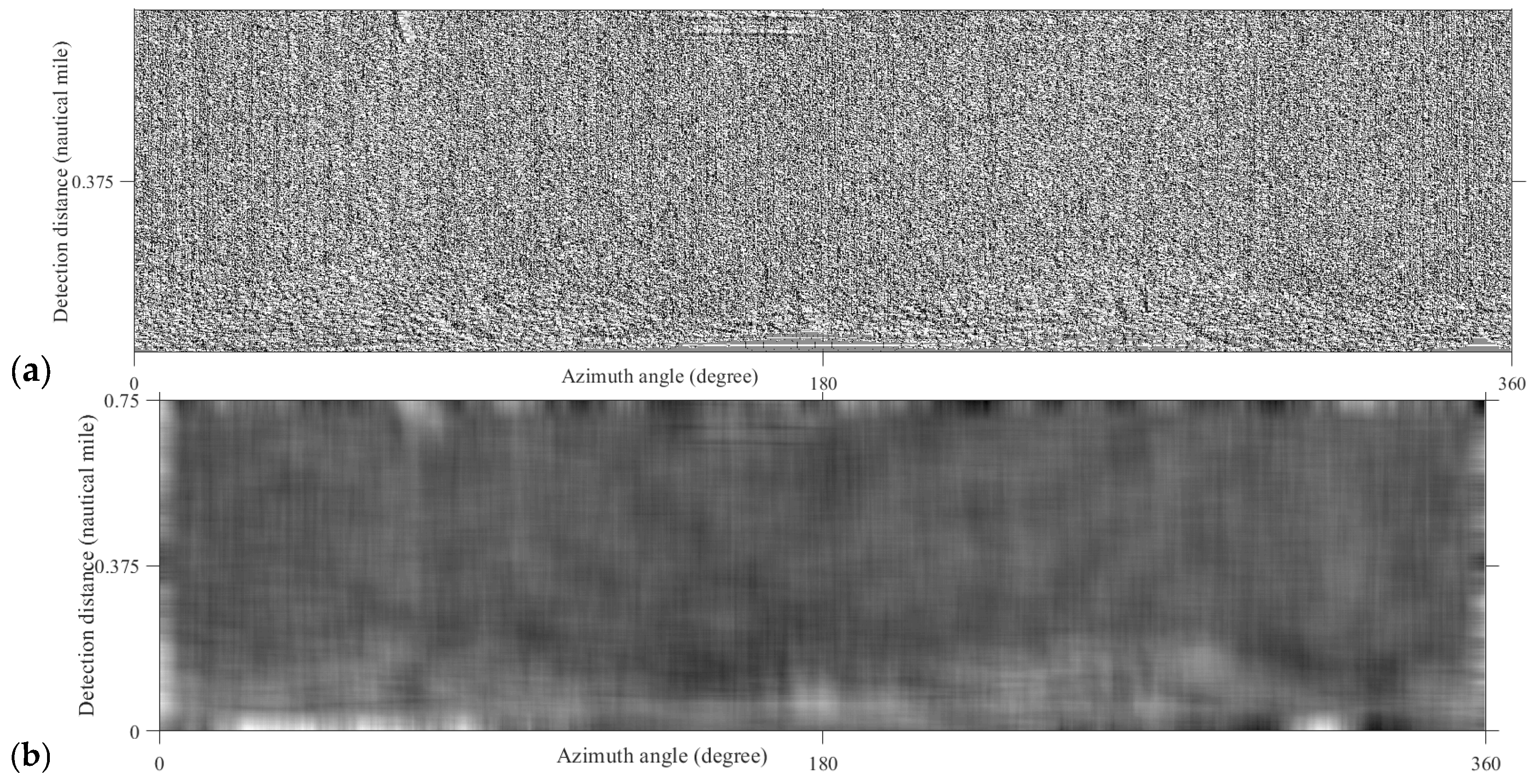
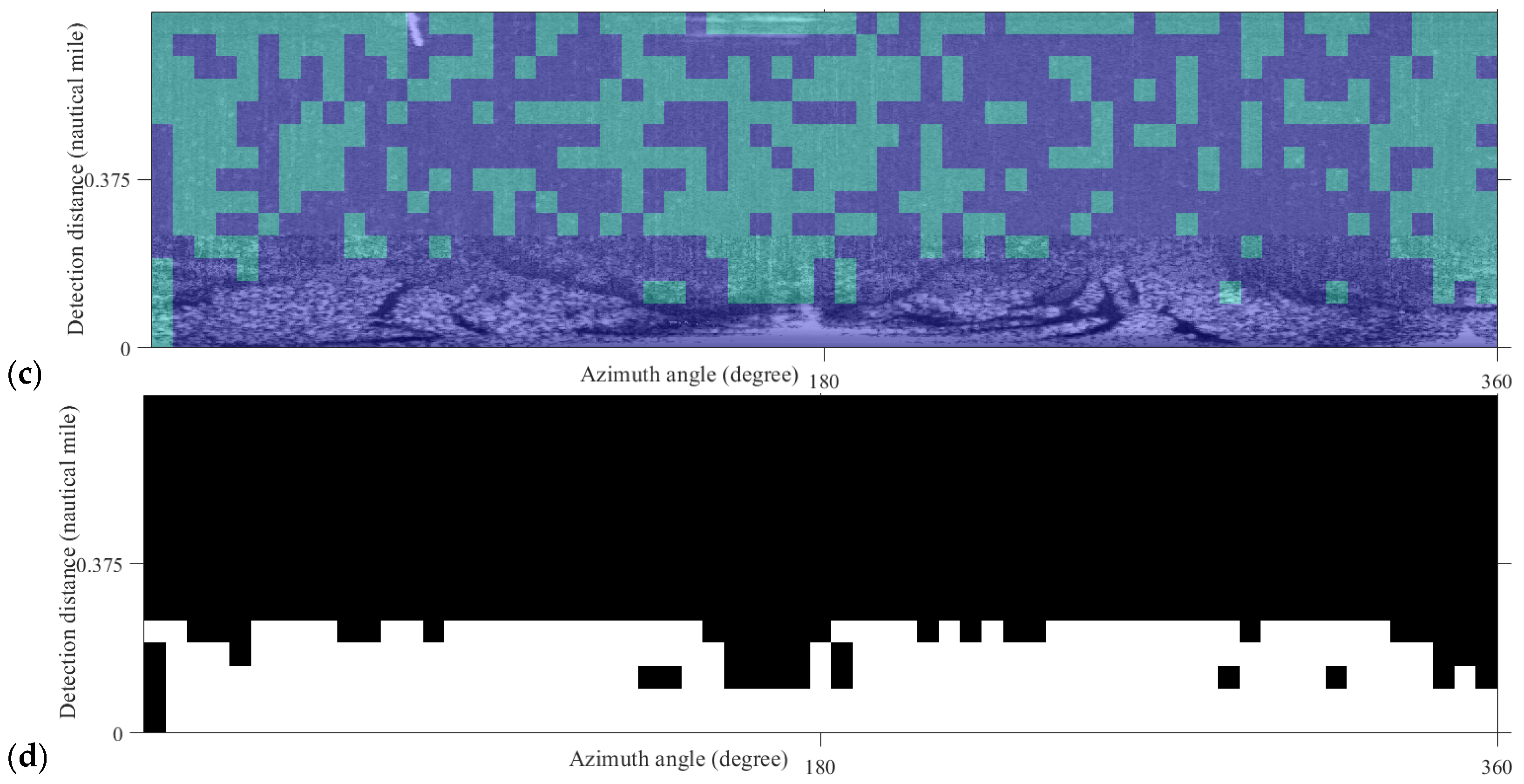

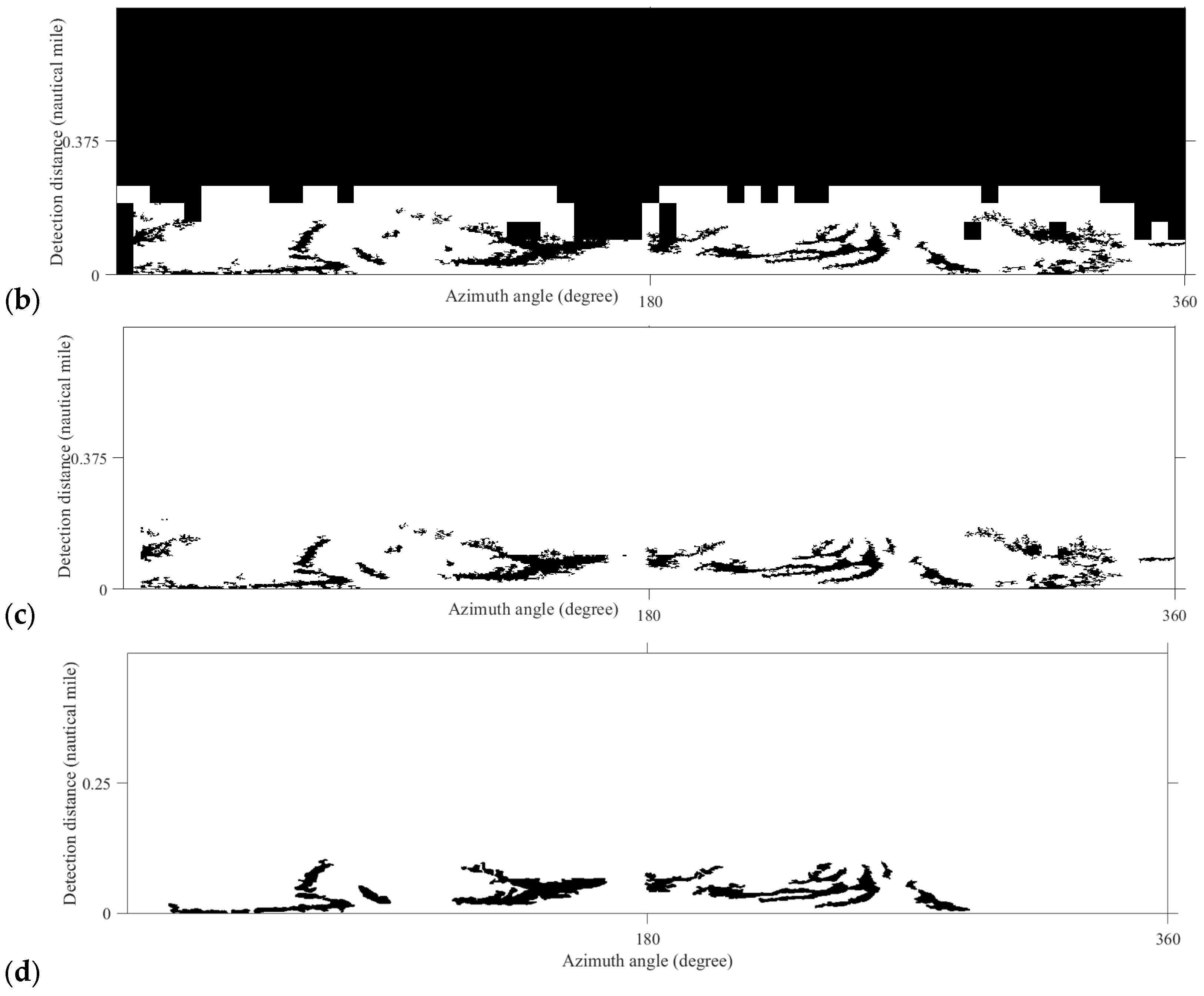
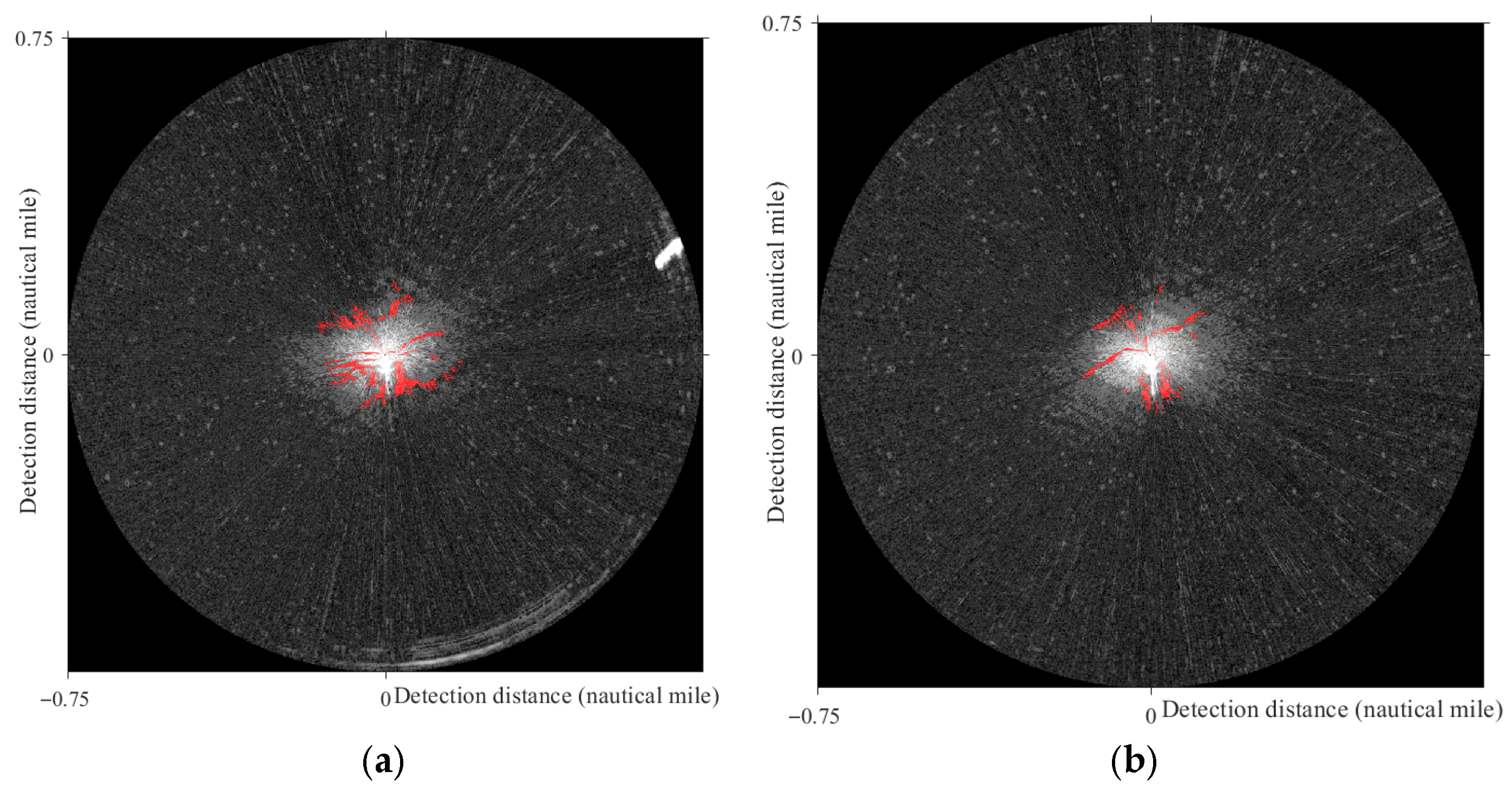
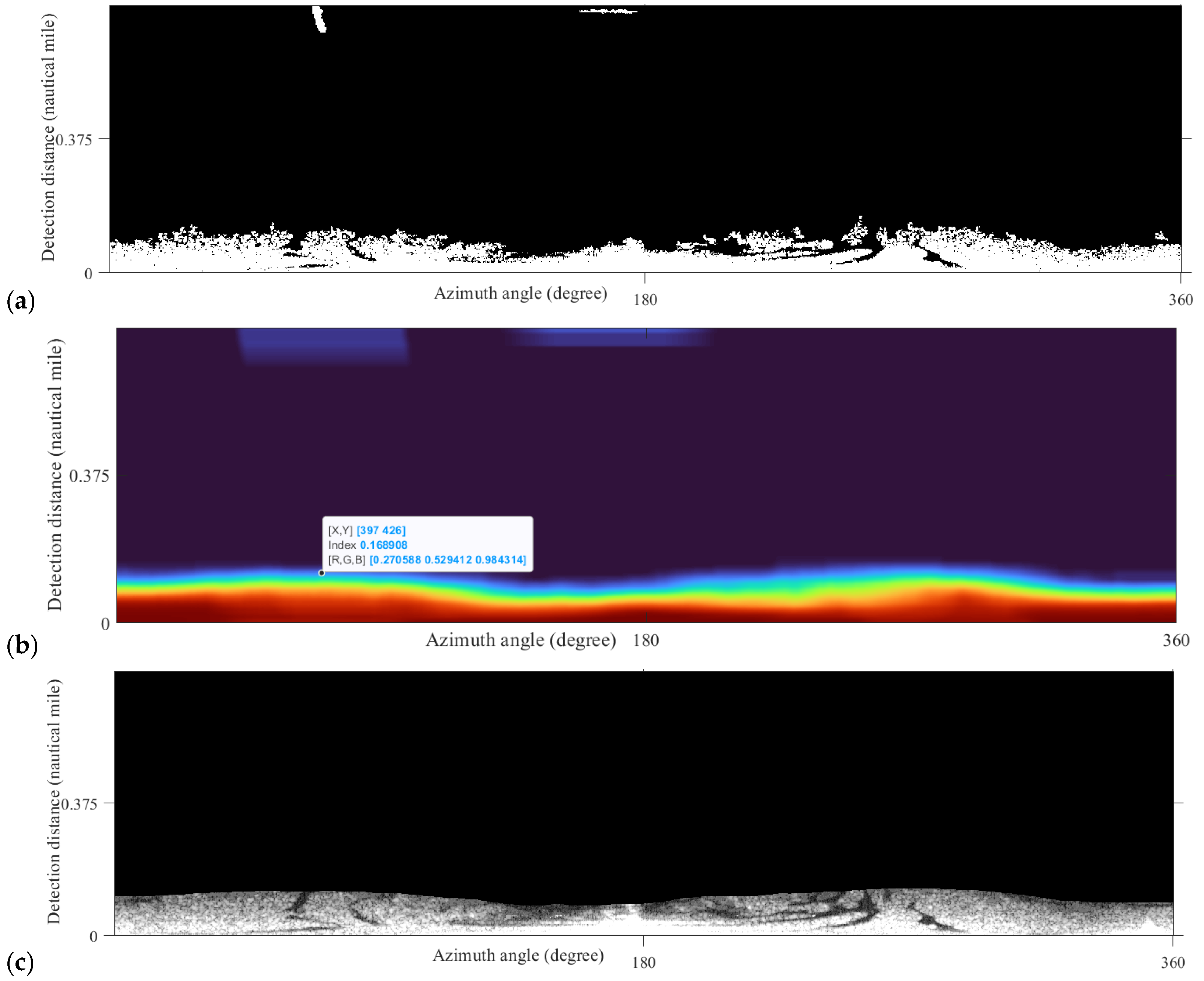

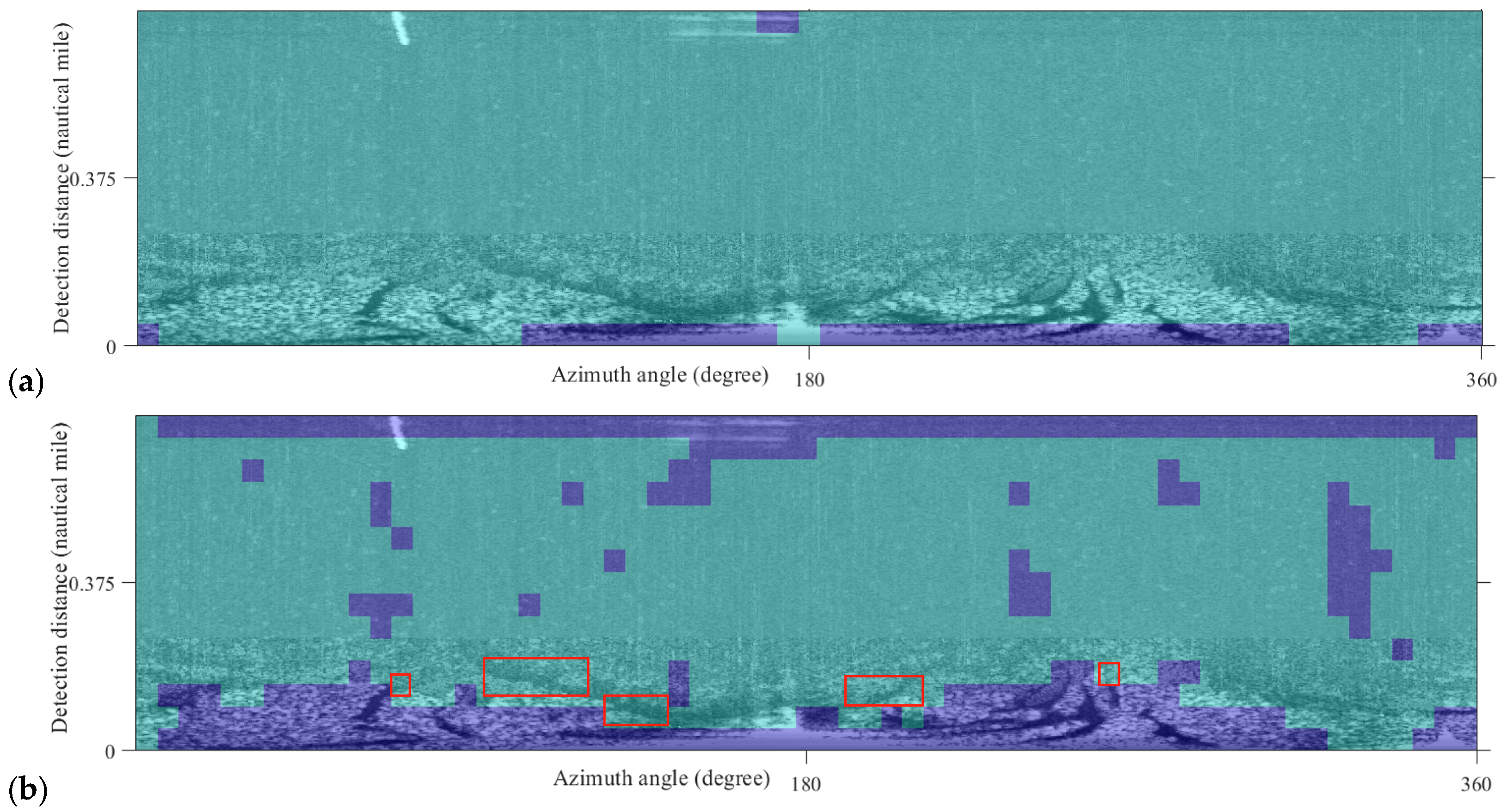
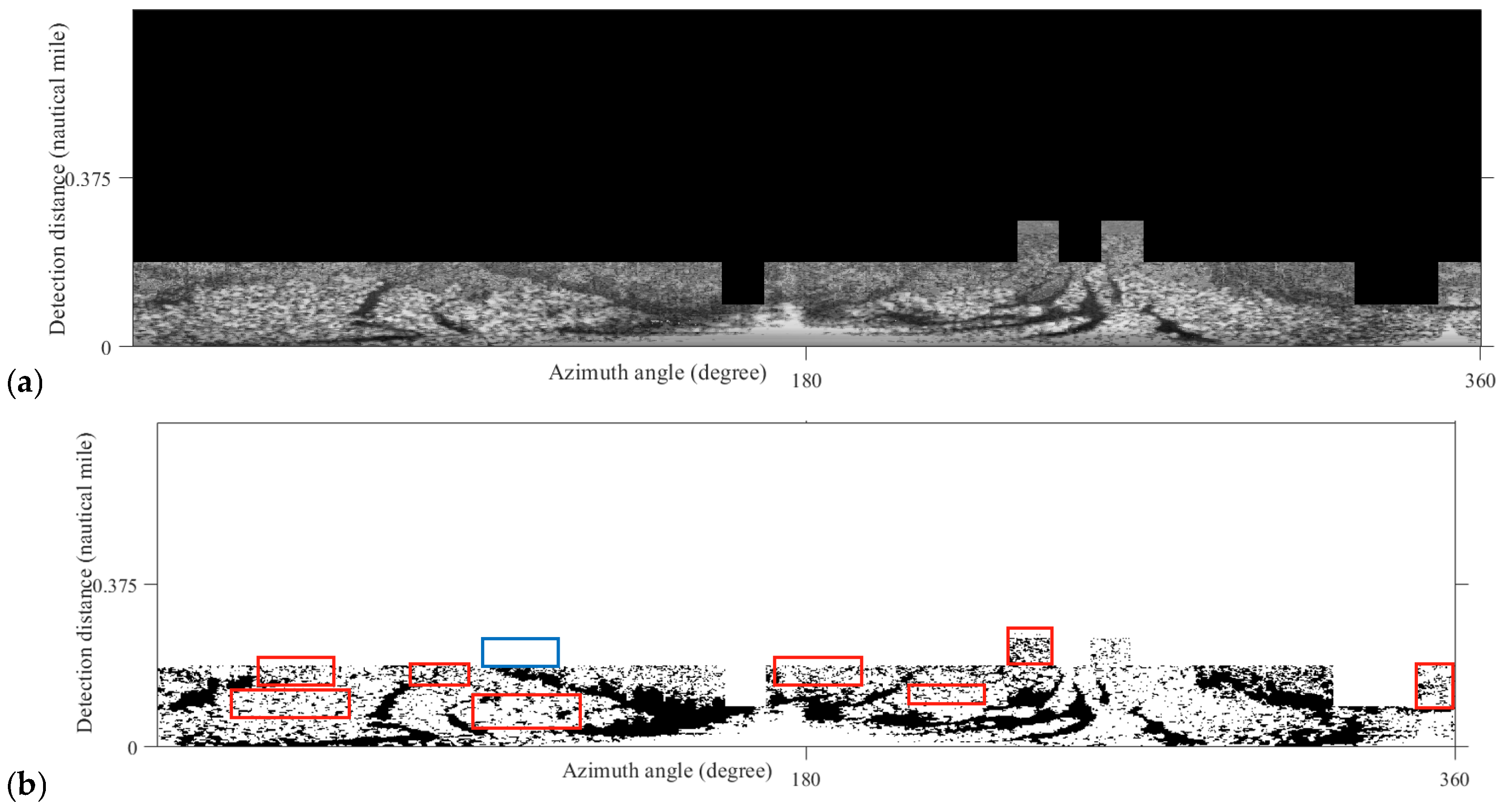
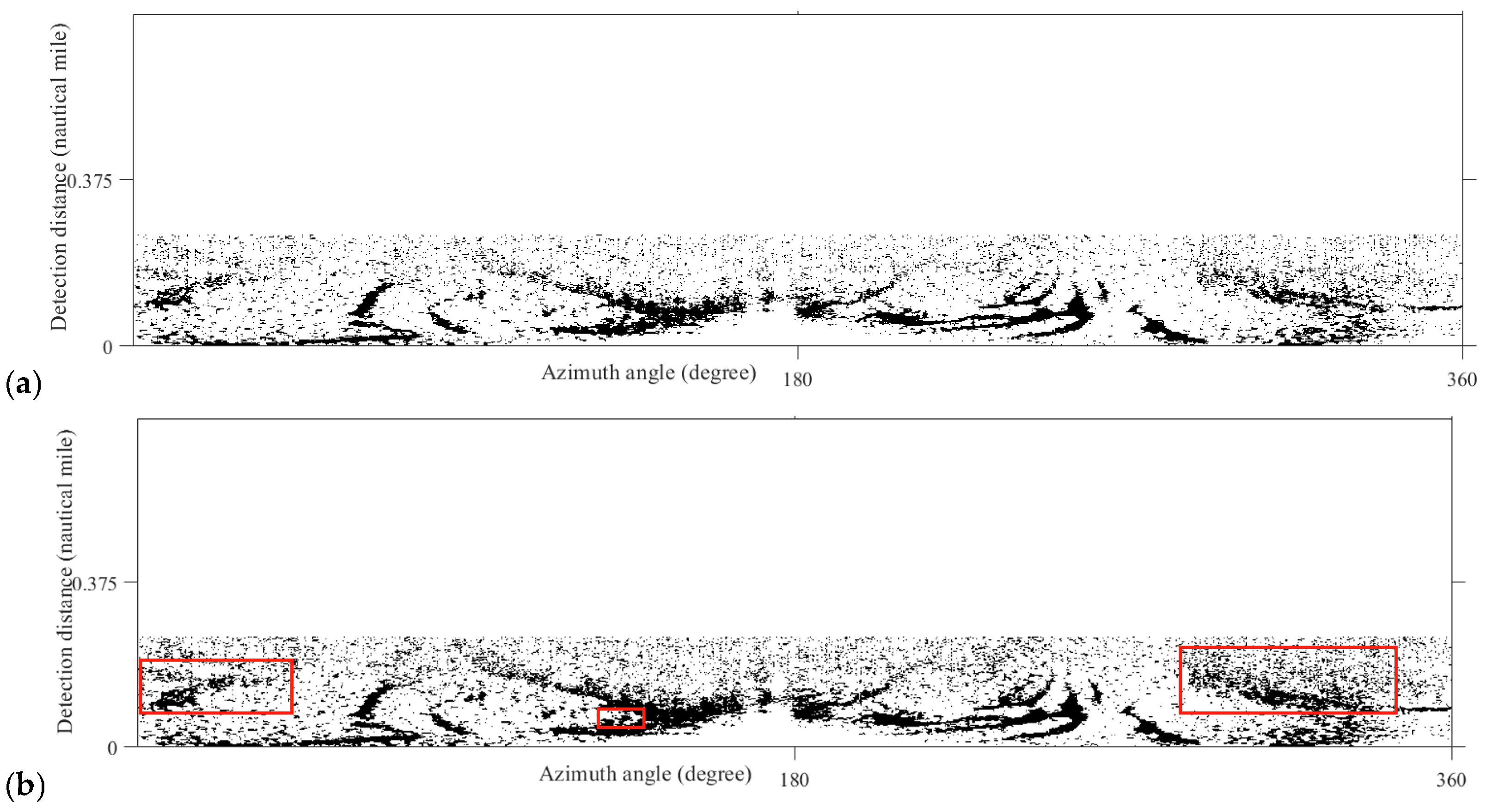
| Parameter Name | Parameter Value |
|---|---|
| Distance resolution | 3.75 M |
| Antenna length | 8 FT |
| Polarization mode | Horizontal Polarization |
| Rotation speed | 28–45 RPM |
| Peak power | 25 KW |
| Detection angle | Horizontal: 0–360°; Vertical: 0–25° |
| Pulse repetition rate | 3000 Hz/1800 Hz/785 Hz |
Disclaimer/Publisher’s Note: The statements, opinions and data contained in all publications are solely those of the individual author(s) and contributor(s) and not of MDPI and/or the editor(s). MDPI and/or the editor(s) disclaim responsibility for any injury to people or property resulting from any ideas, methods, instructions or products referred to in the content. |
© 2025 by the authors. Licensee MDPI, Basel, Switzerland. This article is an open access article distributed under the terms and conditions of the Creative Commons Attribution (CC BY) license (https://creativecommons.org/licenses/by/4.0/).
Share and Cite
Xu, J.; Yao, B.; Dong, H.; Guo, Z.; Xu, B.; Huang, Y.; Li, B.; Qian, S.; Liu, B. Oil Spill Identification with Marine Radar Using Feature Augmentation and Improved Firefly Optimization Algorithm. Remote Sens. 2025, 17, 3148. https://doi.org/10.3390/rs17183148
Xu J, Yao B, Dong H, Guo Z, Xu B, Huang Y, Li B, Qian S, Liu B. Oil Spill Identification with Marine Radar Using Feature Augmentation and Improved Firefly Optimization Algorithm. Remote Sensing. 2025; 17(18):3148. https://doi.org/10.3390/rs17183148
Chicago/Turabian StyleXu, Jin, Boxi Yao, Haihui Dong, Zekun Guo, Bo Xu, Yuanyuan Huang, Bo Li, Sihan Qian, and Bingxin Liu. 2025. "Oil Spill Identification with Marine Radar Using Feature Augmentation and Improved Firefly Optimization Algorithm" Remote Sensing 17, no. 18: 3148. https://doi.org/10.3390/rs17183148
APA StyleXu, J., Yao, B., Dong, H., Guo, Z., Xu, B., Huang, Y., Li, B., Qian, S., & Liu, B. (2025). Oil Spill Identification with Marine Radar Using Feature Augmentation and Improved Firefly Optimization Algorithm. Remote Sensing, 17(18), 3148. https://doi.org/10.3390/rs17183148







